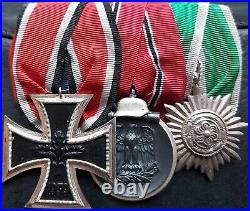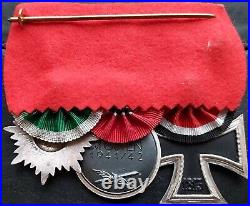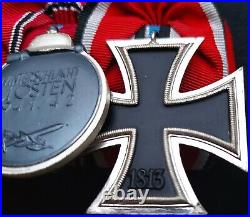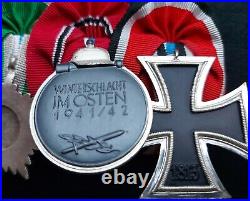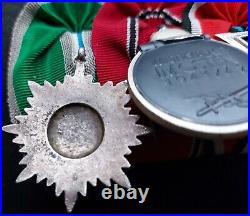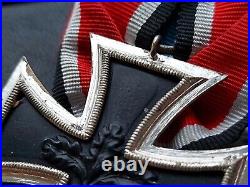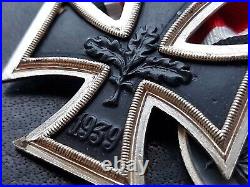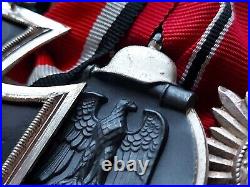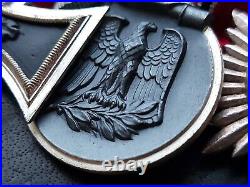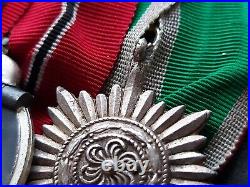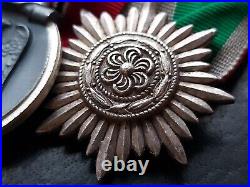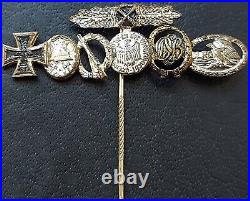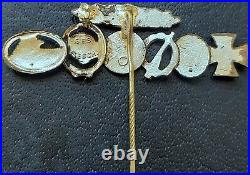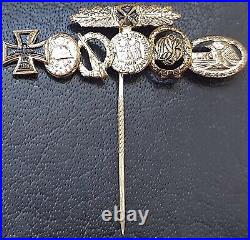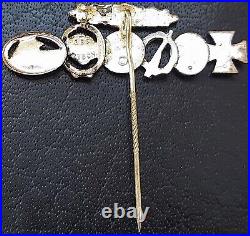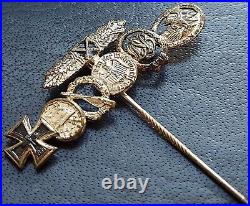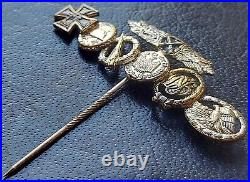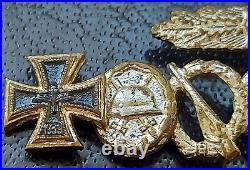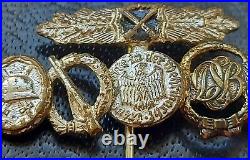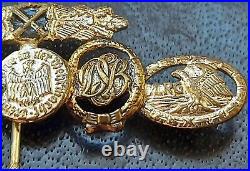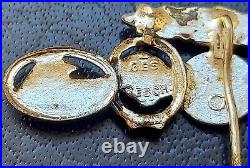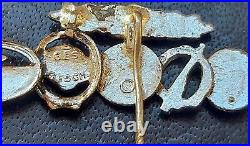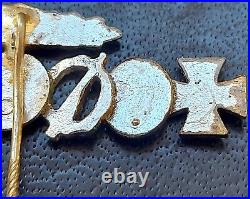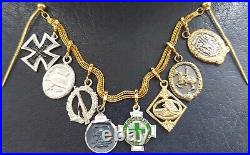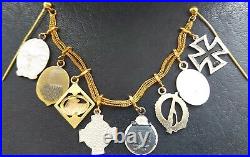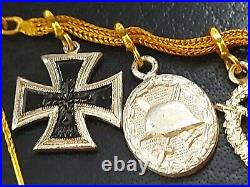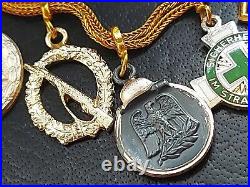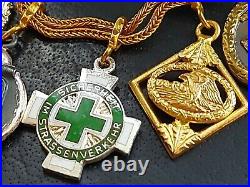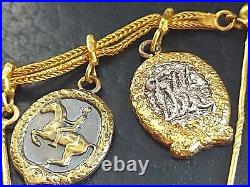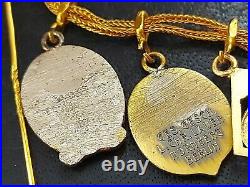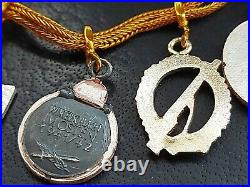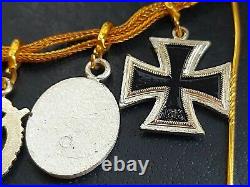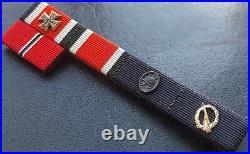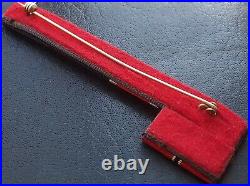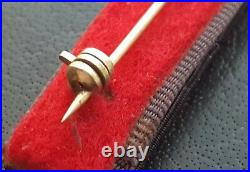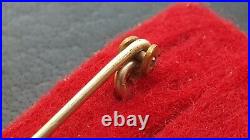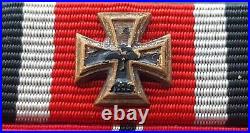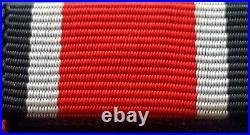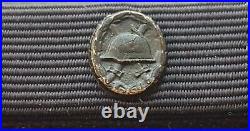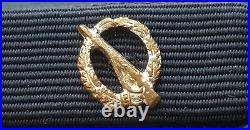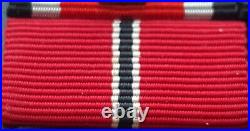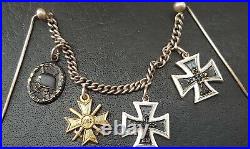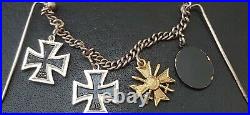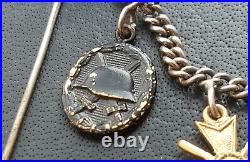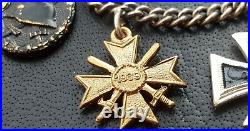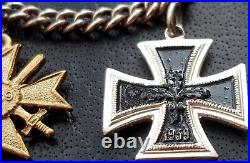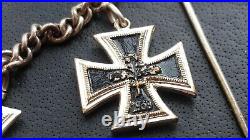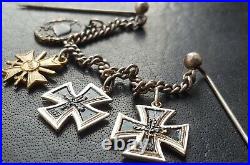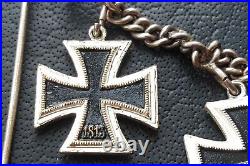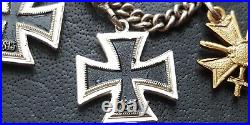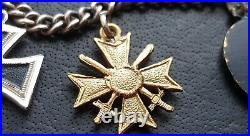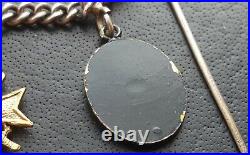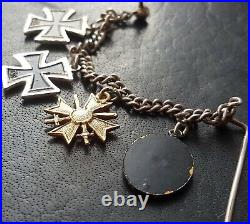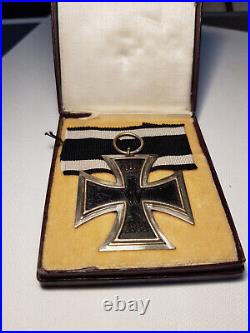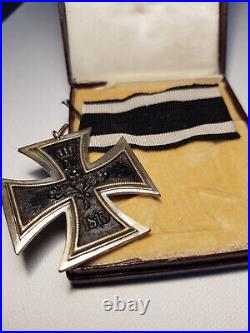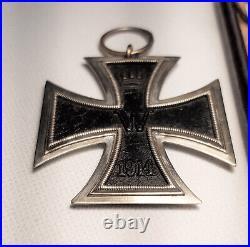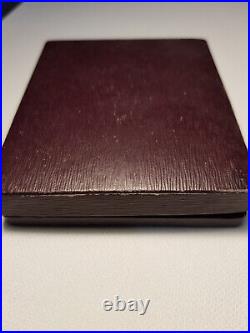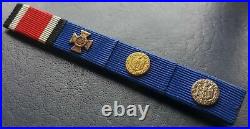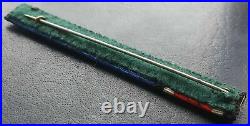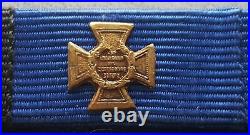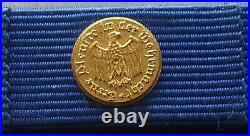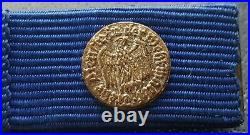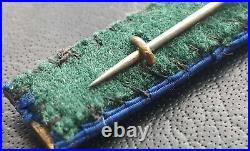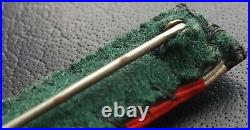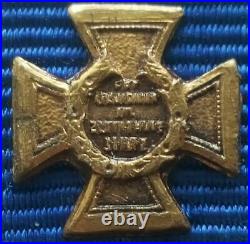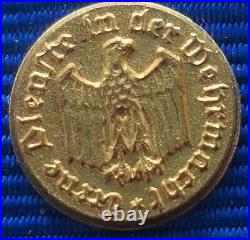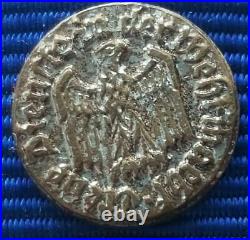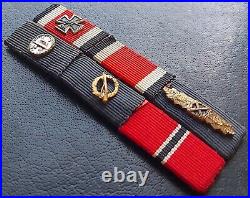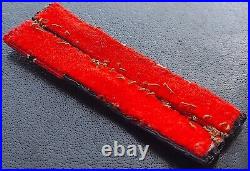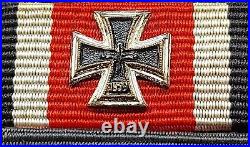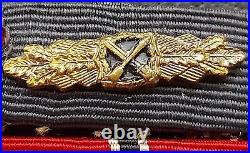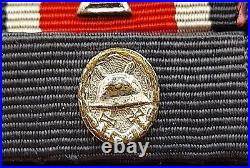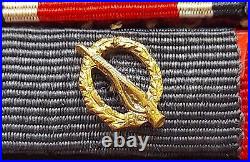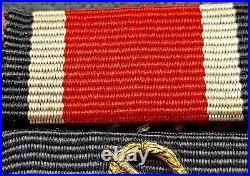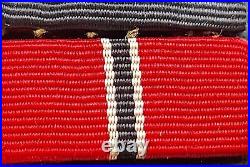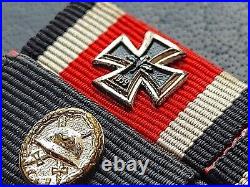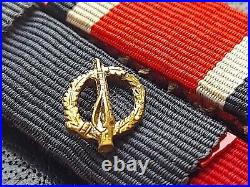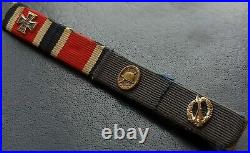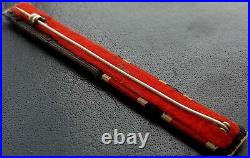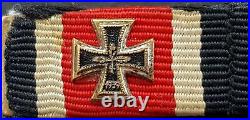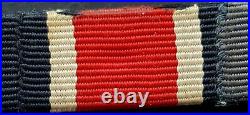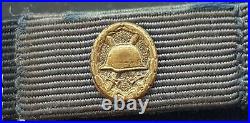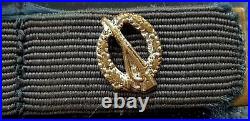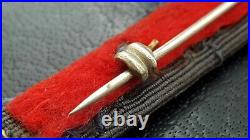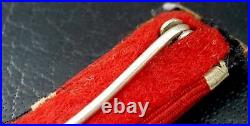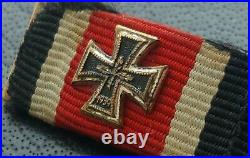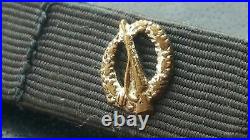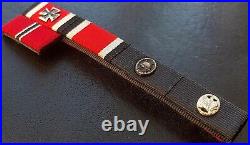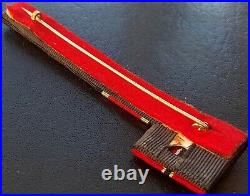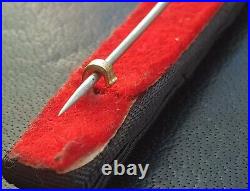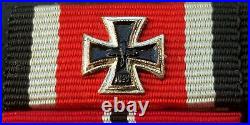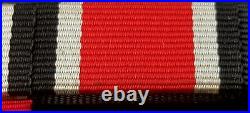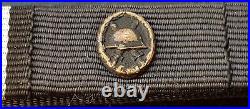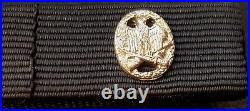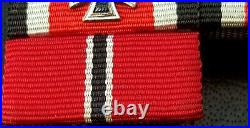Original German post WW2 / 1957 pattern miniature stickpin: Iron Cross 2nd Class, Wound Badge in Silver, Close Combat Clasp in Silver, Infantry Assault Badge in Silver, Long Service Medal for 4 Years, German DSB Sport Badge in Bronze & DLRG Rescue Swimming Badge in Silver, IN PERFECT CONDITION, A VERY DETAILED & NICE STICKPIN. FEW FACTS ABOUT THE 1957 PATTERN GERMAN AWARDS. In 1957 the West German government authorised replacement Iron Crosses with an Oak Leaf Cluster in place of the swastika, similar to the Iron Crosses of 1813, 1870, and 1914, which could be worn by World War II Iron Cross recipients. The 1957 law also authorised de-Nazified versions of most other World War II-era decorations (except those specifically associated with Nazi Party organizations, such as SS Long Service medals, or with the expansion of the German Reich, such as the medals for the annexation of Austria, the Sudetenland, and the Memel region). The main government contract to manufacture and supply these new de-nazified WW2 1957 official decorations went to the world famous German firm Steinhauer & Lueck, Luedenscheid Germany. Knights Crosses, Iron Crosses, Wound Badges, Tank Assault Badges etc were re-designed by Steinhauer & Lück – often with the oak-leaf spray replacing the swastika, with S&L having the sole patent rights to all WW2 1957 German decorations. S&L did not have the whole monopoly on medal making, other famous firms such as Deschler & Sohn, BH Maher and Juncker also manufactured these new German decorations. Lüdenscheid is situated between the cities Dortmund and Bonn. It was here that one of the youngest medal firms was founded in 1889 by August Steinhauer and Gustav Adolf Lück. The first production began in a cellar, the customer base continued to increase. A property was bought at 51 Hochstrasse which is still home for this famous company today. During WW2 Steinhauer & Lück produced medals and badges, like the famous Knights Cross and many other types of medals and badges. In 1957 this company was awarded the contract to produce all the newly re-designed legal WW2 1957 de-nazified decorations, plus the contract to manufacture all of Germany’s official decorations including Germany’s highest order the Bundesverdienstkreuz. Only a very limited number of original WW2 1957 medals are still produced, mainly Iron Crosses, German Cross Gold & Silver & Wound Badges and are considered 100% genuine by the German Government. HISTORY OF THE AWARDS. Iron Cross (German: Eisernes Kreuz) was a military decoration of the Kingdom of Prussia, and later of Germany, which was established by King Friedrich Wilhelm III of Prussia and first awarded on 10 March 1813 in Breslau. In addition to during the Napoleonic Wars, the Iron Cross was awarded during the Franco-German War, the First World War, and the Second World War. The Iron Cross was normally a military decoration only, though there were instances of it being awarded to civilians for performing military functions. Two examples, the civilian pilot Hanna Reitsch was awarded the Iron Cross First Class for her bravery as a test pilot during the Second World War and Melitta Schenk Gräfin von Stauffenberg (also a German female test pilot) was awarded the Iron Cross Second Class. The Iron Cross was also used as the symbol of the German Army from 1871 to 1915, when it was replaced by a simpler Greek cross. In 1956, the Iron Cross became the symbol of the Bundeswehr, the German armed forces. The traditional design is black and this design is used on armored vehicles and aircraft. A newer design in blue and silver is used as the emblem in other contexts. The Iron Cross is a black four-pointed cross with white trim, with the arms widening towards the ends, similar to a cross pattée. It was designed by the neoclassical architect Karl Friedrich Schinkel and reflects the cross borne by the Teutonic Knights in the 14th century. The ribbon for the 1813, 1870 and 1914 Iron Cross (2nd Class) was black with two thin white bands, the colours of Prussia. The noncombatant version of this award had the same medal, but the black and white colours on the ribbon were reversed. Initially the Iron Cross was worn with the blank side out. This did not change until 1838 when the sprig facing could be presented. Since the Iron Cross was issued over several different periods of German history, it was annotated with the year indicating the era in which it was issued. For example, an Iron Cross from the First World War bears the year “1914″, while the same decoration from the Second World War is annotated “1939″. The reverse of the 1870, 1914 and 1939 series of Iron Crosses have the year “1813″ appearing on the lower arm, symbolizing the year the award was created. The 1813 decoration also has the initials “FW” for King Frederick William III, while the next two have a “W” for the respective kaisers, Wilhelm I and Wilhelm II. The final version shows a swastika. It was also possible for a holder of the 1914 Iron Cross to be awarded a second or higher grade of the 1939 Iron Cross. In such cases, a “1939 Clasp” (Spange) would be worn on the original 1914 Iron Cross. A similar award was made in 1914 but was quite rare, since there were few in service who held the 1870 Iron Cross. For the First Class award the Spange appears as an eagle with the date “1939″ that was pinned above the Cross. Although two separate awards, in some cases the holders soldered them together. A cross was the symbol of the Teutonic Knights (a heraldic cross pattée), and the cross design (but not the specific decoration) has been the symbol of Germany’s armed forces (now the Bundeswehr) since 1871. The Iron Cross was founded on 10 March 1813 in Breslau and awarded to soldiers during the Wars of Liberation against Napoleon. It was first awarded to Karl August Ferdinand von Borcke on 21 April 1813. King Wilhelm I of Prussia authorized further awards on 19 July 1870, during the Franco-German War. The Iron Cross was reauthorized by Emperor Wilhelm II on 5 August 1914, at the start of the First World War. During these three periods, the Iron Cross was an award of the Kingdom of Prussia, although given Prussia’s pre-eminent place in the German Empire formed in 1871, it tended to be treated as a generic German decoration. The 1813, 1870, and 1914 Iron Crosses had three grades: Iron Cross 2nd Class German: Eisernes Kreuz 2. Klasse, Iron Cross 1st Class German: Eisernes Kreuz 1. Klasse, Grand Cross of the Iron Cross (German: Großkreuz des Eisernen Kreuzes, often simply Großkreuz). Although the medals of each class were identical, the manner in which each was worn differed. Employing a pin or screw posts on the back of the medal, the Iron Cross First Class was worn on the left side of the recipient’s uniform. The Grand Cross and the Iron Cross Second Class were suspended from different ribbons. The Grand Cross was intended for senior generals of the German Army. An even higher decoration, the Star of the Grand Cross of the Iron Cross, was awarded only twice, to Field Marshal Gebhard von Blücher in 1813 and to Field Marshal Paul von Hindenburg in 1918. A third award was planned for the most successful German general during the Second World War, but was not made after the defeat of Germany in 1945. The Iron Cross 1st Class and the Iron Cross 2nd Class were awarded without regard to rank. One had to already possess the 2nd Class in order to receive the 1st Class (though in some cases both could be awarded simultaneously). The egalitarian nature of this award contrasted with those of most other German states (and indeed many other European monarchies), where military decorations were awarded based on the rank of the recipient. For example, Bavarian officers received various grades of that Kingdom’s Military Merit Order (Militär-Verdienstorden), while enlisted men received various grades of the Military Merit Cross (Militär-Verdienstkreuz). Prussia did have other orders and medals which were awarded on the basis of rank, and even though the Iron Cross was intended to be awarded without regard to rank, officers and NCOs were more likely to receive it than junior enlisted soldiers. In the First World War, approximately four million Iron Crosses of the lower grade (2nd Class) were issued, as well as around 145,000 of the higher grade (1st Class). Exact numbers of awards are not known, since the Prussian archives were destroyed during the Second World War. The multitude of awards reduced the status and reputation of the decoration. The straight-armed Balkenkreuz, the emblem of the Wehrmacht, first used in a narrower form on Luftstreitkräfte aircraft in mid-April 1918, and as shown here, as it appeared on German planes, tanks, and other vehicles during the Second World War. They restored the Iron Cross in 1939 as a German decoration (rather than Prussian as in earlier versions), continuing the tradition of issuing it in various grades. Legally it is based on the enactment Reichsgesetzblatt I S. 1573 of 1 September 1939 Verordnung über die Erneuerung des Eisernen Kreuzes (Regulation for the Re-introduction of the Iron Cross). The Iron Cross of the Second World War was divided into three main series of decorations with an intermediate category, the Knight’s Cross, instituted between the lowest, the Iron Cross, and the highest, the Grand Cross. The Knight’s Cross replaced the Prussian Pour le Mérite or “Blue Max”. They did not care for the Pour le Mérite, as it was a Prussian order that could be awarded only to officers. The ribbon of the medal (2nd class and Knight’s Cross) was different from the earlier Iron Crosses in that the color red was used in addition to the traditional black and white (black and white were the colours of Prussia, while black, white, and red were the colors of Germany). They also created the War Merit Cross as a replacement for the non-combatant version of the Iron Cross. The edges were curved, like most original iron crosses. The standard 1939 Iron Cross was issued in the following two grades: Iron Cross 2nd Class Eisernes Kreuz 2. Klasse, Iron Cross 1st Class Eisernes Kreuz 1. Klasse abbreviated as EKI or E. The Iron Cross was awarded for bravery in battle as well as other military contributions in a battlefield environment. The Iron Cross 2nd Class came with a ribbon and was worn in one of two different methods: when in formal dress, the entire cross was worn mounted alone or as part of a medal bar, for everyday wear, only the ribbon was worn from the second hole in the tunic button. The Iron Cross First Class was a pin-on medal with no ribbon and was worn centered on a uniform breast pocket, either on dress uniforms or everyday outfit. It was a progressive award, with the second class having to be earned before the first class and so on for the higher degrees. It is estimated that some four and a half million Second Class Iron Crosses were awarded in the Second World War, and 300,000 of the First Class. Wound Badge (German: das Verwundetenabzeichen) was a German military award for wounded or frost-bitten soldiers of Imperial German Army in World War I, the Reichswehr between the wars, and the Wehrmacht, SS and the auxiliary service organizations during the Second World War. After March 1943, due to the increasing number of Allied bombings, it was also awarded to injured civilians. It was ultimately one of the most common of all Third Reich decorations, yet also one of the most highly prized, since it had to be “bought with blood”. The badge had three versions: black (representing Iron), for those wounded once or twice by hostile action (including air raids), or frost-bitten in the line of duty; silver for being wounded three or four times, or suffering loss of a hand, foot or eye from hostile action (also partial loss of hearing), facial disfigurement or brain damage via hostile action; and in gold (which could be awarded posthumously) for five or more times wounded, total blindness, “loss of manhood”, or severe brain damage via hostile action. Badges exist in pressed steel, brass and zinc, as well as some base metal privately commissioned versions. Those of the First World War were also produced in a cutout pattern. All versions of the Wound Badge were worn on the lower left breast of the uniform or tunic. The badge was worn below all other awards on the left. It is thought that more than 5 million were awarded during World War II. In 1957, a revised version of the Wound Badge was authorised for wear; however, the previous type could still be worn if the swastika was removed (for example by grinding). The unaltered Second World War version is shown in the illustration to the right. Wound Badges were primarilly manufactured by the Vienna mint, and by the firm Klein & Quenzer. At first, the Wound badge in Black was stamped from sheet brass, painted semi-matt black, and had a hollow reverse with a needle pin attachment. From 1942, Steel was used to make the badges, which made them prone to rust. The Wound Badge in silver was made (before 1942) from silver-plated brass, and (after 1942) from laquered zinc, and had a solid reverse with either a needle pin or a broad flat pin bar. The Wound Badge in Gold was a gilded version of the Wound Badge in Silver. Heer Infantry Combat Badge, more commonly referred to as the Infantry Assault Badge, was designed by C. Junker of Berlin and instituted on December 20, 1939 by Generaloberst von Brauchitsch. The initial class was instituted in silver and decorated foot infantry who participated in combat action earning a degree of experience that qualified them for the badge. A separate class, in Bronze, was instituted on June 1, 1940. The Bronzed class had criteria similar to the requirements the Silver. There was, however, one notable distinction; The status of the troops, bronzed meant motorized Panzer troops, silver meant foot infantry. The Infantry Assault Badge consists of an oval wreath of oak leaves, made up of four leaves on each side of the arch. Every oak leaf has two acorns, one on each side of the base of the leaf. Centered at the bottom of the badge is a ribbon tied around the wreath, with five raised pellets in a vertical position at the center of this ribbon. The Badges most distinguishable feature is the K98 rifle positioned diagonally across award. The butt of this rifle, positioned on the right, is slightly below the wreath. It leans to the left, with its fixed bayonet protruding through the last of the four oak leaves. The rifle sling forms a loop, hanging from the stock to the butt. Surmounting the wreath is the national emblem; an eagle with down swept wings clutching a swastika in its talons. The badge has intricate detailing from the eagle down to the bolt on the rifle. The Infantry Assault Badge measures 46mm across and was slightly convex with either a solid or hollow back, and could be die stamped or cast. The reverse had a vertical pin with a hinge that was attached to the back of the eagle, with a retaining “C” clip which retained the clip. The method of attachment for the clip varied, some were welded or soldered while others had a more elaborate scheme where the pin sits in a recessed location the edges of which are crimped in order to hold the hinge in place (pictured above in the Bronzed version). The award was also available in a lapel pin miniature version to be worn whilst in civilian clothing. Heer Close Combat Bar was instituted on November 25, 1942, in order to recognize the courage of the German soldier in hand-to-hand combat. This award was completely independent of the Infantry Combat Badge. The badge designed by Wilhelm Ernst Peekhaus of Berlin (his name preceded by FEC can be found on the reverse of some examples), and was instituted in three classes, bronze, silver, and gold. The badge is die cast and generally manufactured in zinc, though examples in tombac or aluminum are also found.. It is slightly convex, with the center piece consisting of the national emblem surmounting a crossed bayonet and hand grenade. This piece is cut out and backed with a flat square of blackened steel (magnetic), crimped in place on the reverse. The pin is always broad in the center and tapering at the end. The bar varies in length from between 95 to 97.5mm, and in height from between 25 to 27mm according to the Juncker, JFS and F&BL types. Presentation of the badge was made by the company, Battalion or Regimental Commander (or equivalent). On March 26, 1944, A. Reserved the right to personally present the close combat bar in gold as “the highest infantry decoration”. On August 30, 1944, the gold class recipients were automatically presented the German cross in gold and were permitted to spend 21 days at home. The Close Combat Badge decoration was to be worn 1 centimeter above the ribbon bar or mounted group. When more than one grade was presented to the same individual, only the highest grade was to be worn (though the recipient kept all grades in his possession). An award document was given to the soldier (different types exist, it depending on the unit), and there was an entry in his Soldbuch attended with a detailed list of his combat days (unit, date, location). The close combat bar was presented in a cardboard box or in celluloid. The badge was presented based on the number of combat days as follows: Bronze class for 15 combat days, Silver class for 30 combat days, Gold class for 50 combat days. Criteria for a combat day was as follows. All combat days in which the soldier had the opportunity to be close enough to “see the white of the enemy’s eyes”, use close combat weapons to assault the enemy man-to-man and be victorious. Days in which the soldier was part of a mayor attack or assault, reconnaissance attack, defense of a position, or single messenger run. These actions could take place in the front line or in the rear (against Partisans). The initial combat days were established taking in count the uninterrupted time of engagement on the Eastern front since June 22 of 1941, or in Africa since March 26 of 1943: 15 months = 15 combat days, 12 months = 10 combat days, 8 months = 5 combat days. This decoration was also awarded posthumously, in which case both decoration and certificate were sent to the next of kin. The Division commander was also able authorize the award to a wounded soldier who, because of permanent injury, would no longer have the opportunity to complete the minimum days, provided he completed the following: Bronze Class – 10 days minimum, Silver Class – 20 days minimum, Gold Class – 40 days minimum. The Close Combat Bar was also awarded to members of the Luftwaffe, though it would later replaced by the Luftwaffe Close Combat Bar (Few is known about this badge, and no picture exist of its wear). This article be not complete without a mention of the gold bar presentation. According to Manfred Dörr’s book on this subject, about 600 gold bar were awarded. The bar was in every respect the same design than the other classes, but gilded – a special fire gilded badge does exist. This badge was presented during an official ceremony. Long Service Award (Wehrmacht-Dienstauszeichnungen) – A year after the reinstitution of the draft Germany reinstated the Long Service Awards (March 16th, 1936). All members of the Armed Forces were eligible for the award which was bestowed in five classes; four years, twelve years, eighteen years, twenty five years and fifty years. The four year service medal was mat silver and had on the obverse the Wehrmacht Eagle and the inscription “Treue Diesnste in der Wehrmacht” (Loyal Service in the Armed Forces). On the reverse it bore only the number 4 in the center surrounded by oak leaves. The twelve year award was the same design but slightly larger, in bronze, and with the number “12″ replacing the “4″ on the reverse. Those who served eighteen years were presented a silver Maltese cross featuring the Wehrmacht eagle in the center obverse and the number “18″ on reverse. The same design was maintained for the next and highest class, awarded to those veterans who served twenty five years. The cross in this instance was gold, larger, and naturally had “25″ on the reverse. A special grade for 40 years of service was also approved; This was an oak leaves set which was worn on the ribbon of the 25 years award. All levels of the award were held on blue ribbons with the appropriate branch of service attached to it. It was either the spread wing eagle for the Army and Navy or the flying eagle for the Air Force. Only two long service awards were to be worn at the same time. The 4 and 12 year classes were obviously to be worn together, but once the individual received the 25 year class, he would wear it with the 4 year class, and if the 40 year class were achieved then it would be worn with the 12 year class. The award was worn as part of a group or in the ribbon bar for daily wear. During its early years of existence the award was normally constructed of German silver and heavily plated, but from 1942 on it was made from gold or silver washed zinc. During the last year of the war, presentation of the award ceased. The German Sports Badge (German: Deutsches Sportabzeichen) is a decoration of the German Olympic Sports Federation DSB, of the Federal Republic of Germany. It exists in a civilian and military version. The German Sports Badge test is carried primarily in Germany, but any German citizen living abroad may apply to become judges and hold tests on their own, and the decoration can be awarded to any person participating in the test. Some times it is also possible for a non-german foreign citizen to obtain judging-qualifications, if there are no other judges in their local area. This has only been done once, when a Danish firefighter was given judging-powers in 2009, due to the fact that there were no judges at all in Denmark. The German Sports Badge, also known as the “German National Sports Badge” was first created in the year 1912 and is one of the oldest awards of Germany still in active circulation. The Pour le Mérite is another older award which is still issued in Germany, although the criteria for that decoration has changed since its original issuance as a military order. Between 1914 and 1933, the German Sports Badge was issued for the completion of various physical tests by the young male population. As a military award, during the inter-war years of the 1920s and prior to 1933, the German National Sports Badge was one of the few military awards bestowed to the peacetime Reichswehr. Between 1933 and 1939, the German Sports Badge was overshadowed by an almost identical decoration, the SA Sports Badge which was a sports badge issued by the Party. Even so, the German Sports Badge was still regarded as an important qualification badge, and both the SA Sports Badge and German Sports Badge could both be earned and displayed. The SS considered the German Sports Badge of particular importance and the decoration was one which was commonly listed in SS service records. Notable SS recipients of this award include Reinhard Heydrich and Amon Göth. After World War II, the German Sports Badge was continued as a federal decoration in West Germany and continued in this status after German reunification. Today, the German Sports Badge is both a civilian decoration and a military award of the Bundeswehr. The German rescue swimming badge (German: Deutsches Rettungsschwimmabzeichen) is awarded by the Wasserwacht of the German Red Cross and the DLRG for proficiency in rescue swimming skills. The German rescue swimming badge is awarded in bronze, silver, and in gold. The awards is available as a cloth patch, as a metal badge, or as a ribbon. The rescue swimming badges in silver and gold are permitted to be worn on uniforms of the Bundeswehr, the German Police and various rescue services as a ribbon. It is also an entry-requirement for some German Police agencies. In 1913 the DLRG offered its first rescue swimming classes. By the year 1922, 7997 rescue swimming certificates, 2038 badges in bronze, and 676 instructors’ certificates were awarded. German Lifeguard Association Deutsche Lebens-Rettungs-Gesellschaft e. DLRG is a relief organization for life saving in Germany. The DLRG is a non-profit, independent organization based on volunteers. On 28 July 1912, a pier in Binz on the island Rügen, Germany collapsed under the load of 1000 people waiting for the cruise steamer Kronprinz Wilhelm. Sailors of the German navy were able to save most people, but 17 people died because they could not swim, including seven children. This catastrophe caused the foundation of the “Deutsche Lebens-Rettungs-Gesellschaft (DLRG)” (German lifesaving organization) on October 19 1913 in Leipzig. With almost 560’000 members in approximately 2,100 local groups, the DLRG is the largest voluntary water rescue organization in the world. Including donators, over one million people support the work of the DLRG. This item is in the category “Collectables\Militaria\World War II (1939-1945)\Medals/ Ribbons”. The seller is “a..anderson” and is located in this country: GB. This item can be shipped worldwide.
- Type: Badges
- Conflict: World War II (1939-1945)
- Era: 1945-Present
- Country/ Organization: Germany
- Theme: Militaria
- Service: Army
- Featured Refinements: Miniature Medal
- Country/Region of Manufacture: Germany
